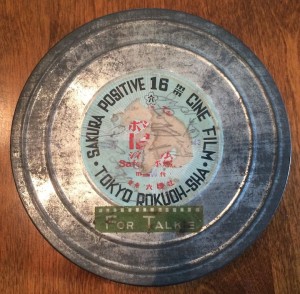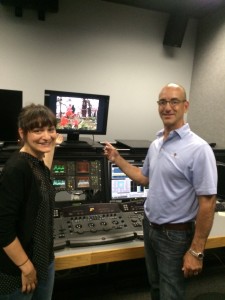My first substantive blog post for this website coincides with the massive project that has consumed the better half of this summer, making sense of my film collection. When I began this project, collecting films was not a priority, despite my background in film studies. There were good reasons for this at the time: for one, I began this project intending to explore new territory in terms of both media and method of research. That all changed when an internet collector colleague alerted me to an intriguing 16mm film can for sale with a Sakura film label. When the can arrived at my doorstep, I was startled to find a reel of film inside. This turned out to be reel 2 of Women in Japan (日本の女性, Japan 1941), and it was readily apparent that it was in an advanced stage of decomposition (visibly warped, with the pungent odor of “vinegar syndrome,” or acetate film base degradation). This film has a unique background that has been researched by film scholar Ikegawa Reiko, and it warrants a post of its own. This event was the primary factor in my decision to take a year off from work to attend the L. Jeffrey Selznick Program of Film Preservation at George Eastman House International Museum of Photography and Film here in Rochester. This was also the beginning of my film collection, which to date includes approximately 150 16mm, Regular 8mm, and Super 8mm titles.
In April I received funds from the University of Rochester to digitize the most relevant titles in the collection for this website. As a start, Selznick school alum and soon-to-be Visual and Cultural Studies graduate student Almudena Escobar López did preliminary research on the 16mm titles and prepped them for transfer, and on 12 June we drove the trunkful of reels to Kodak’s Entertainment Industry Digital Systems Laboratory. This resource was also, fortunately, “just up the road.” It goes without saying that this part of the project would have been much more involved and costly had I lived elsewhere. [1.1.16 update: this former Kodak facility is now the George Eastman Museum Digital Laboratory].
Almudena and I were concerned about the feasibility of transferring several of the 16mm titles. In addition to Women in Japan, there were a few other reels that were visibly warped, and a number of the (primarily Eastman) color films were faded.
When we arrived at the lab, however, Kodak Senior Colorist Kyle Alvut put a faded color reel on his Spirit DataCine film scanner and showed us how he could recover the latent color data of faded prints with the da Vinci color corrector. The moment I saw the revived color on the monitor I had an epiphany that changed my feelings toward the piles of film cans that had taken up residence in our dining room over the past 5-6 years (prompting my husband to refer to our home decor sensibility as “Early Archival”).
While waiting for the 16mm films to be digitized, I did some preliminary research on the Super 8mm and Regular 8mm film titles and prepped the Super 8mm titles for Kyle. (The Regular 8mm titles will be transferred at George Eastman House.) I also tackled copyright issues–more complex for the 16mm titles than for the smaller gauges–head-on. This is the most bewildering research I’ve had to do to date for this project; I have had to make peace with the fact that the process is more often than not inherently open-ended. Two weeks after we left the 16mm titles with Kyle he called to say that he’d finished the transfers and I could pick everything up after the 4th of July weekend.
Since then, I have been going over the 50-odd digitized titles one by one, checking credits, length, and other data against the Film Condition Reports that Almudena prepared while prepping the films last month. I’ve also been able to do some sleuthing on a few of the more obscure titles, such as the two missionary films, Kyoto Story (US, ca. 1950) and Kyoto Saturday Afternoon (US, ca. 1952) and one complete outlier, a film made by the Philadelphia Dairy Council (ca. 1961), Lantern Serenade. I created a Facebook page for updates on my research progress, and I have been posting a few interesting details about the films as I work through them. The films were scanned at 1920×1080 un‐compressed with a pillar box to maintain the correct aspect ratio, using the da Vinci color corrector to recover the color of faded prints. Scans were made at 24fps, with some dust busting to clean each film of artifacts. An Apple pro res 4:2:2 HQ 1920×1080 file was made for each film.
In the throes of copyright research, I declared that the summer I decided to watch all the Godzilla movies back to back was “much, much, much more fun,” but in truth it has been exhilarating to experience these films coming alive again.



